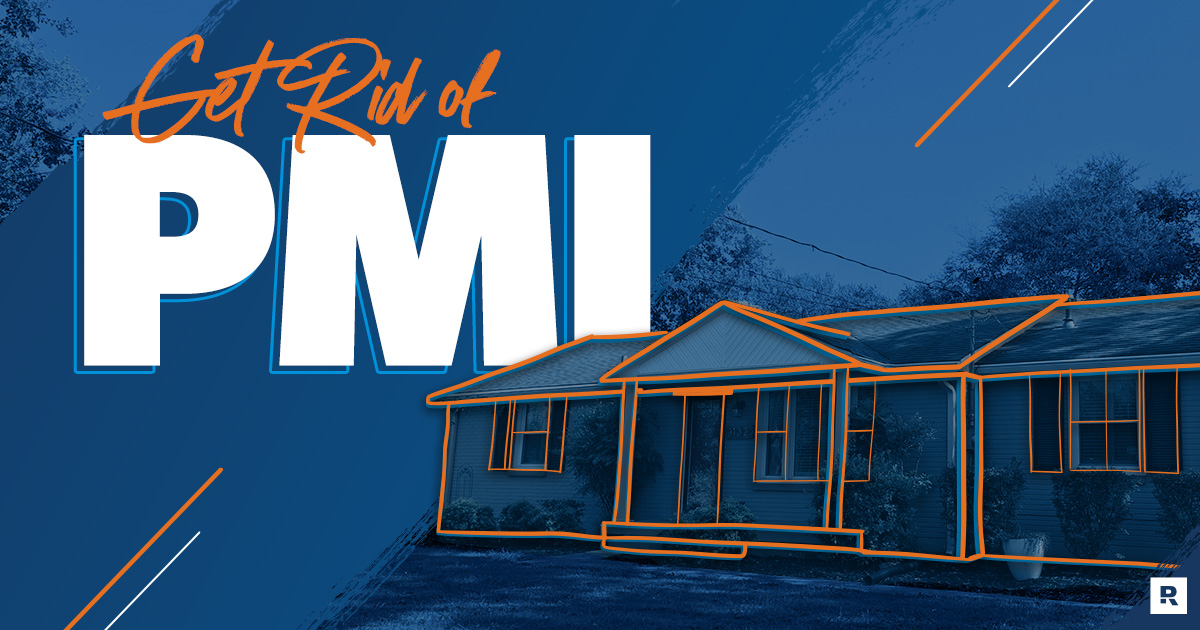
Your big ol’ mortgage payment. It’s probably the highest bill you pay each month (though gas has been creeping up on it lately). But if your house payment includes private mortgage insurance (PMI), getting PMI removed can save you up to a few hundred bucks a month.
So, how do you get rid of PMI? We’ll give you all the info you need.
When Does PMI Go Away?
PMI is a fee added to your mortgage if you made less than a 20% down payment. Depending on how much you put down, PMI can cost anywhere from 0.19–1.86% of your loan balance per year. It protects your lender—not you—in case you stop making payments on your loan.1
So when does PMI go away? As a general rule, you can get PMI removed once you have 20% equity in your home. This equity can be a combination of the payments you’ve made and how much the house has gone up in value.
For example, if you bought a home for $300,000 and put 10% down ($30,000), you’d need an additional $30,000 (10%) in equity in your home before PMI can be removed. So you could pay your mortgage down by $30,000 to get to 20% equity. But let’s say you paid your mortgage down by $5,000, and your home’s value increased $25,000 to $325,000—boom, you’ve got $30,000 in equity.
In markets where home values are increasing by double-digit percentages, you can get rid of PMI early. But if you made a small down payment or live in an area where home values are stagnant, it’ll take a little more work to get PMI off your back.
Ways to Get Rid of Mortgage Insurance
Hey, we get it. PMI is annoying. You don’t really get any benefit from it as a homeowner, so the sooner you can remove PMI from your mortgage payment, the better.
How can you get rid of PMI early? Do you have to get an appraisal to get PMI removed? We’ll cover all that and show you four ways to kick PMI to the curb.
Get the right mortgage from a trusted lender.
Whether you’re buying or refinancing, you can trust Churchill Mortgage to help you choose the best mortgage with a locked-in rate.
Pay Down Your Mortgage to Have PMI Removed Automatically
Here’s the deal: Mortgage lenders are required to cancel PMI once you’ve paid your mortgage down to 78% of your home’s purchase price or after you’ve reached the halfway point of your loan term.
Making minimum payments and waiting for your mortgage company to automatically cancel PMI is the slowest way to get rid of mortgage insurance. Seriously, if you have a 15-year mortgage, you could pay PMI for up to 7.5 years. And a 30-year mortgage? You’ll be on the hook for as much as 15 years of PMI. No thanks!
But you can get PMI removed early if you make extra payments toward your mortgage’s principal.
Dave Ramsey recommends one mortgage company. This one!
And while lenders automatically cancel PMI based on the original value of your home, they won’t take into account how much your home’s value has grown unless you ask them to. So, you’ll need to get an appraisal to say goodbye to PMI early based on your home’s current value (more on that later).
Request a PMI Cancellation
You can contact your lender and request an early termination of PMI as soon as you’ve paid your mortgage down enough to have an 80% loan-to-value ratio (LTV). It might not seem like a big deal just to wait for the automatic cancellation at a 78% LTV, but those couple of percentage points could save you a year or more of paying PMI.
Some lenders might require an assessment to make sure the property value hasn’t declined in value before they’ll cancel your PMI.
Get an Appraisal
If you live in an area where home prices have skyrocketed (meaning you live just about anywhere in America), you could be sitting on enough home equity to remove PMI. But before your lender will cancel your PMI, you’ll need to get an appraisal to prove your home is worth more than you paid for it. And no, your neighbor Phil’s opinion won’t count as an appraisal.
Many lenders (like Fannie Mae) also require a two-year “seasoning requirement,” meaning you can’t have PMI removed until you’ve made two years’ worth of on-time payments—even if your equity has grown above 20%. If it’s been less than five years, you might even be required to have 25% worth of equity.2
Sometimes you can get around the two-year seasoning requirement if you’ve made improvements to your home—like remodeling a kitchen or putting in a pool—that increased the overall value.
Before you do anything though, talk to your mortgage company because they all have different rules for canceling PMI. They also can tell you how much your house will need to appraise for in order to cancel PMI.
Instead of an appraisal, which will cost you about $350, some companies might accept a cheaper option called a broker price opinion done by a real estate expert.
But before you even consider an appraisal, make sure you have at least 20% equity in your home. You might even want to have 25% equity just in case the appraisal is a little lower than you thought.
Want More Expert Real Estate Advice?
Sign up for our newsletter! It’s packed with practical tips to help you tackle the housing market and buy or sell your home with confidence—delivered straight to your inbox twice a month!
Refinance Your Loan to Get Rid of PMI
If you have lender-paid mortgage insurance (mortgage insurance paid through a higher interest rate) or are having difficulty getting your mortgage company to cancel PMI, you’re going to have to refinance your loan.
Be cautious if you decide to go this route because refinancing is expensive. You’ll probably have to pay thousands of dollars in closing costs to refinance your loan, and you could get stuck with a higher interest rate.
In the current market where mortgage rates are at 14-year highs, it could be difficult to get a lower rate than your current one. So when you get your new loan, you could end up spending more on interest than you were paying for PMI. If that’s the case, there’s no point in refinancing.
If you have a 30-year-mortgage, refinancing to a 15-year mortgage (our recommendation) could help you break even since they usually have lower interest rates and the shorter term will save you thousands of dollars in interest. Long story short, sit down and do some math before refinancing.
And one more tip: If you have an FHA loan with a mortgage insurance premium (MIP) and put down less than 10%, refinancing is your only option to get rid of mortgage insurance. But if a refinance doesn’t make sense, MIP goes away automatically after 11 years if you made a 10% down payment.3
Use PMI Savings to Pay Off Your House Sooner
Okay, so let’s say you jump through all the hoops, get PMI removed, and end up saving $200 a month on your mortgage payment. Now, if you’re following the 7 Baby Steps, you can use that extra money for whatever Baby Step you’re on—from paying off debt to building a fully funded emergency fund to saving 15% for retirement.
But if you’re on Baby Step 6 and working to pay off your house early, just keep making the same house payment as when you had PMI. That extra $200 a month could knock several years off your mortgage.
Let’s say you owe $300,000 on your home and have a 15-year mortgage. An extra $200 could help you pay off your home a year and a half early and save you $15,000 in interest. That's huge, folks.
Moral of the story: Get to work and kick PMI to the curb for good! It's 100% worth it.
Next Steps
- If you want to see whether refinancing will give you a lower interest rate and help you get rid of PMI, connect with the RamseyTrusted home loan specialists at Churchill Mortgage.
- Check out our free mortgage payoff calculator to see just how much sooner you could pay off your house by getting rid of PMI and putting that extra money toward your mortgage.
Did you find this article helpful? Share it!

We Hear You!
We’re considering adding the ability to save articles to your Ramsey account.




